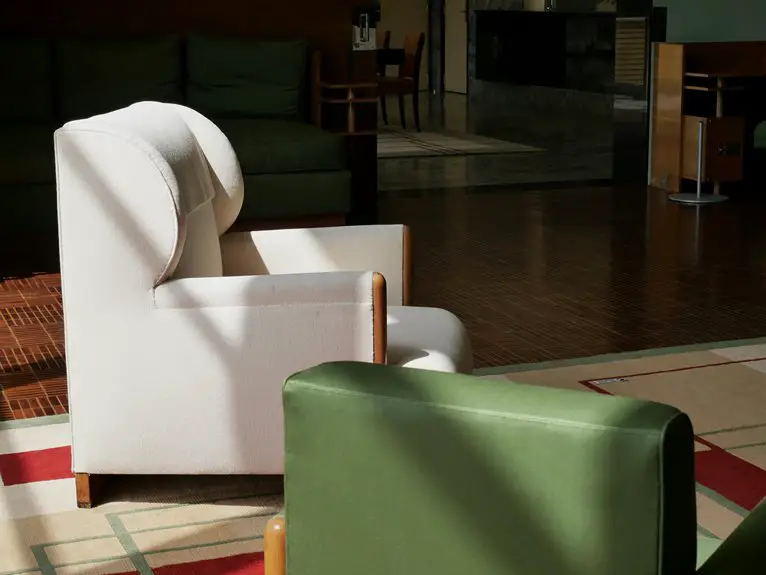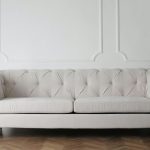When you choose upholstery for your sofa or chair, breathability often gets overlooked. Yet, it plays a vital role in comfort, especially during long sittings or warmer months. You want a fabric that allows air flow, feels good against your skin, and stands up to daily use. But with so many materials available, how do you find the perfect balance between durability and ventilation? Let’s explore what makes some fabrics stand out.
Table of Contents
Key Takeaways
- Cotton, linen, and wool are the top natural fibers known for excellent breathability and comfort in upholstery fabrics.
- Performance polyester and Crypton fabrics provide breathable, durable, and stain-resistant synthetic alternatives.
- Linen’s loosely woven texture enhances air circulation, making it ideal for warm and humid climates.
- Breathable fabrics prevent moisture buildup, reducing odor, bacteria, and mildew for long-lasting freshness.
- Regular vacuuming and avoiding over-wetting preserve fabric breathability and prolong upholstery life.
Benefits of Choosing Breathable Upholstery Fabrics
Although you mightn’t always notice, breathable upholstery fabrics make a big difference in comfort. When you choose these fabrics, you’re improving comfort levels by allowing air to circulate freely, which helps prevent overheating and moisture buildup. This means you’ll feel cooler and more comfortable, even during long sitting sessions.
Breathable fabrics also play an essential role in odor control. Since they reduce trapped moisture, they help minimize the growth of bacteria and mildew, which are common causes of unpleasant smells. By selecting breathable upholstery, you’re investing in a cleaner, fresher environment for your living space.
This choice not only enhances your immediate comfort but also contributes to the fabric’s long-term freshness and durability.
Top Natural Fibers for Breathable Upholstery
When selecting breathable upholstery, natural fibers stand out for their excellent airflow and comfort.
You’ll find that cotton, linen, and wool are top natural fiber types known for their breathability and fiber durability. Cotton offers softness and moisture-wicking properties, making it ideal for warmer climates.
Cotton, linen, and wool lead in breathability and durability, with cotton ideal for warm climates due to its softness and moisture-wicking.
Linen, with its loosely woven texture, enhances ventilation while providing strength and longevity. Wool, though thicker, naturally regulates temperature and resists moisture, adding durability without sacrificing comfort.
These fibers not only promote airflow but also maintain their integrity over time, ensuring your upholstery remains both breathable and resilient.
Popular Synthetic Alternatives With Breathable Qualities
You’ll find that some synthetic fabrics offer impressive breathability alongside durability.
Performance polyester, Crypton fabric, and microfiber each bring unique features that balance comfort and function.
Let’s explore how these materials might fit your upholstery needs.
Performance Polyester Benefits
Because performance polyester combines durability with breathability, it stands out as a popular synthetic alternative for upholstery fabrics.
You’ll appreciate the performance polyester advantages, like its resistance to wrinkles, fading, and stains, making your sofa or chair look fresh longer.
The fabric’s moisture-wicking properties help keep you comfortable by allowing air to pass through, which prevents overheating during extended use.
When it comes to performance polyester durability, this fabric holds up well against daily wear and tear, making it ideal if you have pets or kids.
Plus, it’s easy to clean and maintain, so you can enjoy both style and function without hassle.
Choosing performance polyester means you don’t have to sacrifice breathability for strength.
Crypton Fabric Features
Although synthetic, Crypton fabric offers impressive breathability alongside its well-known stain resistance and durability.
When you choose Crypton, you get a fabric designed to handle spills and stains without trapping moisture or heat. Its crypton stain resistance means liquids bead up and don’t soak in, making cleanup simple and quick.
Plus, the crypton durability guarantees your upholstery stands up to daily wear without compromising comfort.
You’ll notice that Crypton’s breathable qualities come from its unique moisture barrier, which still allows air circulation, preventing that sticky, overheated feeling often associated with synthetic fabrics.
If you want a practical, easy-care fabric that doesn’t sacrifice breathability, Crypton is a smart choice for sofas and chairs in homes with active lifestyles.
Microfiber Breathability Considerations
Crypton sets a high bar for combining durability and breathability in synthetic fabrics, but microfiber also offers appealing qualities worth considering.
When you choose microfiber, you benefit from its excellent microfiber durability, making it resistant to wear and tear. However, microfiber moisture management varies—while it’s less breathable than natural fibers, advanced weaves can improve airflow and comfort.
Keep these microfiber breathability considerations in mind:
- Microfiber’s dense weave can trap heat but resists stains and moisture effectively.
- Look for microfiber blends with enhanced airflow to boost breathability.
- Its durability makes it ideal for high-traffic areas, balancing comfort and longevity.
Maintenance Tips for Keeping Fabrics Breathable
To keep your breathable upholstery fabrics performing at their best, you’ll need to adopt specific maintenance habits that prevent dirt and oils from clogging their fibers.
Use gentle cleaning techniques like vacuuming regularly with a brush attachment to remove dust without damaging the fabric. Spot clean spills immediately using mild detergent and lukewarm water to avoid stains setting in.
Moisture control is essential; avoid over-wetting the fabric during cleaning, as excess moisture can encourage mold growth and reduce breathability. Allow your upholstery to air dry completely after any cleaning sessions.
Additionally, keep your furniture out of direct sunlight to prevent fabric deterioration.
Design Considerations for Different Climates and Lifestyles
When selecting breathable upholstery fabrics, you should consider how your local climate and daily activities affect fabric performance.
Fabrics with strong climate adaptability guarantee comfort whether you face humid summers or chilly winters. Equally important is lifestyle compatibility—your upholstery should suit your household’s activity level and maintenance preferences.
Choosing upholstery that matches both your climate and lifestyle ensures lasting comfort and suitability.
For instance, active families require durable, easy-to-clean breathable fabrics, while quieter homes might prioritize softness and texture.
Keep these design considerations in mind:
- Choose materials that wick moisture and enhance airflow for humid climates
- Opt for insulating breathable fabrics in colder regions
- Select stain-resistant breathable fabrics if you have pets or kids
Challenges and Solutions With Breathable Upholstery Fabrics
Although breathable upholstery fabrics offer great comfort, you’ll face some challenges like durability concerns, moisture retention, and stain susceptibility.
To guarantee your fabric lasts, focus on fabric durability by choosing materials tested through rigorous breathability testing that also withstand wear and tear.
Some breathable fabrics may trap moisture, leading to mildew or odors, so look for treatments or blends designed to wick moisture away effectively.
Stains can be tougher to clean on lightweight, porous textiles, but selecting fabrics with stain-resistant coatings or opting for removable, washable covers can help.
Regular maintenance, such as vacuuming and prompt cleaning, also extends fabric life.
Frequently Asked Questions
How Does Fabric Weave Affect Upholstery Breathability?
You’d think tightly packed threads would let air dance freely, but ironically, a looser woven texture actually improves airflow dynamics. When you choose upholstery, remember: the weave’s openness directly affects how breathable your fabric feels.
Are There Eco-Friendly Treatments to Enhance Fabric Breathability?
You can choose eco-friendly options like natural enzyme or water-based fabric treatments to enhance breathability. These treatments improve airflow without harmful chemicals, so your upholstery stays comfortable and sustainable at the same time.
Can Breathable Upholstery Fabrics Reduce Indoor Allergens?
You can improve allergen reduction by choosing breathable upholstery fabrics, which help prevent dust and moisture buildup. This enhances indoor air quality, making your living space healthier and more comfortable for everyone.
What Is the Lifespan of Breathable Upholstery Fabrics Compared to Synthetics?
When it comes to durability comparison, breathable fabrics might not always outlast synthetics, but they shine in maintenance requirements. You’ll find breathable options easier to care for, so their lifespan often balances out in everyday use.
How Do Breathable Fabrics Perform in High-Traffic Commercial Settings?
You’ll find breathable fabrics perform well in high-traffic commercial settings when they pass durability testing. Just follow maintenance tips like regular cleaning and prompt stain removal to keep them looking fresh and lasting longer.
- Does Chiffon Fabric Stink - July 15, 2025
- Does Chiffon Fabric Affect the Economy - July 15, 2025
- Does Cotton Fabric Have a Nap - July 15, 2025







